 I always remember in my days of teacher training when we learnt about the mysterious birds that laid their gigantic ice eggs on my lecturer’s front lawn. Bigger than a football, yet ovoid in shapes, (as many eggs are) we gasped in wonder at these magnificent things – imagining what bird could have produced them! As our suspension of disbelief became less willing we began to think like scientists; what could we find out about them? We began weighing, measuring and drawing them, observing how they changed over time. Then we decided to try and keep them as intact as possible for when the errant parents came back. We predicted that unless put into a freezer they would melt into a large puddle of water, but surely we could slow this process…
I always remember in my days of teacher training when we learnt about the mysterious birds that laid their gigantic ice eggs on my lecturer’s front lawn. Bigger than a football, yet ovoid in shapes, (as many eggs are) we gasped in wonder at these magnificent things – imagining what bird could have produced them! As our suspension of disbelief became less willing we began to think like scientists; what could we find out about them? We began weighing, measuring and drawing them, observing how they changed over time. Then we decided to try and keep them as intact as possible for when the errant parents came back. We predicted that unless put into a freezer they would melt into a large puddle of water, but surely we could slow this process…
I’ve carried out a number of variations on this insulation investigation over the years and it always goes down well. As post graduate students we loved playing along with this tale and as a teacher whether it is ice eggs, ice hands or whatever shapes you wish – children love it too!
So, if you are teaching about changing state and the properties of materials here are a few ideas.
Read the adventures of the investigation loving alien, Selenia in this colourful comic, which introduces changes of state. Children test different materials to see which would make the best insulator to slow down the melting of ice.
Make observations of the different frozen substances and predict what liquids they once were. Children may suggest other liquids they would like to freeze and observe the resulting solids.
While we’re on the topic of all things frozen, a nice challenge and assessment question is to ask children if they think a snowman will melt more quickly or more slowly whilst he’s wearing a coat.
Children may think that the water has leaked out when observing condensation forming on the outside of the glass containing a cold drink. Carrying out a comparative test using two cans of a drink, one which is at room temperature and one from the fridge will help them better understand this. Water droplets will form on the outside of the cold can. This will help them to see that water vapour in the air will condense to form water on a cold surface.
This role-play activity has children physically representing particles to help them to develop an understanding of changing state. Solid ice which is composed of closely packed particles is heated and melts to form a liquid in which molecules move around more freely. The liquid water is then heated to boiling point and some particles float off around the classroom as the liquid changes into a gas.
This short clip helps children see that chocolate changes from a solid to a liquid when heated and back to a solid when cooled. Children will love seeing how chocolates are made and how the science of changing state has applications in the real world. Making crispy cakes or even chocolates if you are more adventurous is a great activity, which children will enjoy whilst helping them learn more about changing state.
Children could investigate which type of chocolate melts fastest, or look at the speed at which other solids melt. There are some great ideas here.
When looking at irreversible reactions, why not use space as an engaging context for working scientifically? The activity on page 26 of the main file is great fun and provides children with an opportunity to use equipment carefully whilst exploring volcanic eruptions mimicked using bicarbonate of soda and vinegar.
This short video, which demonstrates the formation of carbon on a tile as a candle burns is a great way of showing an irreversible reaction. There has been a chemical change and a new substance, (carbon) has been produced. This demonstration could be shown in class with children drawing and explaining their observations.
Creating plastic from milk sounds impossible and as the two materials are so different it is a good way of showing that an irreversible reaction has occurred resulting in the formation of a new material. Add vinegar to milk and watch the milk separate into a solid and a liquid known as curds and whey. Remove the water by filtering then drying in an oven to leave casein, a brittle plastic.
This activity looks at irreversible changes and the formation of a new material by burning. Children are asked to consider different types of transport and the fuel that is used to make them work. They also list examples of transport which do not burn fuel in order to work.
The changes that happen in both reversible and irreversible reactions are extremely difficult to understand and explain because they are happening at a molecular level, something which primary age children may struggle to understand. However many of these activities will certainly show them how amazing science is and hopefully get them asking more questions!
